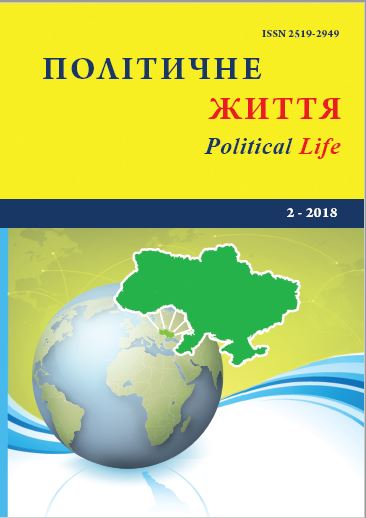Regional elite in the context of symbolism (1994 – 2004).
DOI:
https://doi.org/10.31558/2519-2949.2018.2.11Keywords:
Dnepropetrovsk group, Donetsk group, Elite, L. Kuchma, Kuchmogate, RegionsAbstract
Understanding democracy as D. Sartori as "an electoral polyarchy", the status of political elites depends on the level of popular support. The democratic values which should declare elites, become values of the people. But in the conditions of influence of regional elites which created their own political matrix at the all-Ukrainian level, understanding of democratic values was provincial. Therefore, they not only did not become nationwide, but led to a crisis in the political regime. Absence of the intention to find consensus resulted in absence and convergence of regional elites. And in spite of shadow agreements and the mechanisms of influence open of artificial declaring and the technology of destruction of competitors, political Ukraine elite was forced to concede Majdana’s requirements.
Political confrontation between regional elites during the reign of L. Kuchma has several stages. Initially, the victory in the election of a representative from Dnipropetrovsk led to the involvement of a resident of the city from the President’s team. The long-standing confrontation between Dnipropetrovsk and Donetsk elites began, which ended with the appearance of Viktor Yanukovych. The Crimean regional elite, due to the secret intervention of Kiev, was focused on its own internal conflicts, which led to the destruction of the authoritative figure of Yu. Meshkov. The role of the Kharkiv regional elite, which became an influential lever of the President and its support in the parliament after 2002, has gradually increased. The constant struggle between Dnipropetrovsk and Donetsk, Kharkiv and Donetsk has led to confrontation with the Kiev elites with Donetsk
Analyzing the activities of the political elite of the times of L. Kuchma, we can distinguish three groups that had a certain influence on the nature of the political regime’s change: the ruling elite, the shadow elite and the counter-elite. Inside each group and between them there was no formation of uniform strategy, as each group had its own model of the idea of national state. Two main models which influence development of the democracy in transitional societies : the model of “pact” and the model “convergences” were not carried out in Ukraine.
References
Бондаренко К. П. Леонид Кучма / Художник-оформитель Е. В. Вдовиченко. – Харьков: Фолио, 2009. – 217 с.
Зоткин А. Роль региональных элит и столичного истеблишмента в формировании властной элиты Украины // Социология: теория, методы, маркетинг. – 2004. – №3. – С. 95 – 108.
Мацієвський Ю. Еліти в Україні до і після помаранчевої революції // Політичний менеджмент. – 2010. – №. 2. – С. 38-55.
Корреспондент. – 2003. – №35 (74). –12 вересня. – С. 16.
Корреспондент. – 2002. – №15. – 5 липня. – С.16.
Корреспондент. – 2003. – №40(79). – 18 жовтня. – С.6.
Україна молода. – 2001. – №202(1765). – 2 листопада. – С.2.
Корреспондент. – 2002. – №25. – 13 вересня. – С.26.
Корреспондент. – 2002. – №30. – 22 жовтня. – С.6.
Корреспондент. – 2004. – №42(131). – 6 листопада. – С.7.
Хигли Д. Демократия и элиты //Полития: Анализ. Хроника. Прогноз (Журнал политической философии и социологии политики). – 2006. – №. 2. – С. 22-31.

